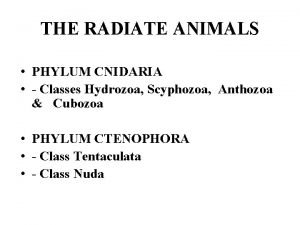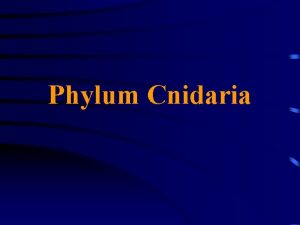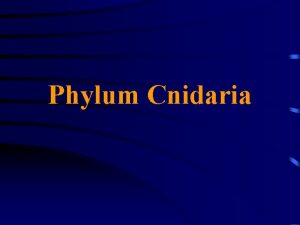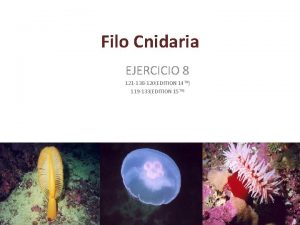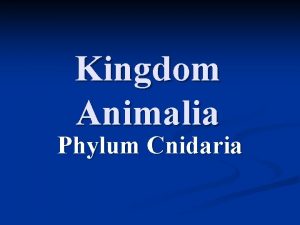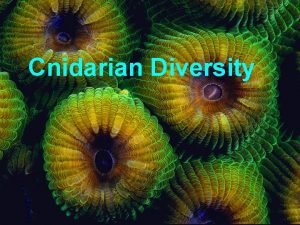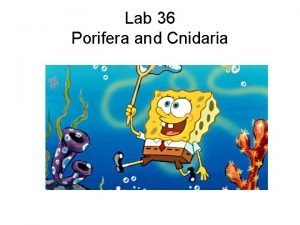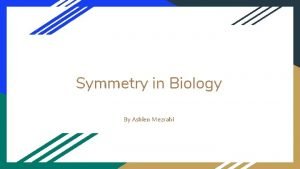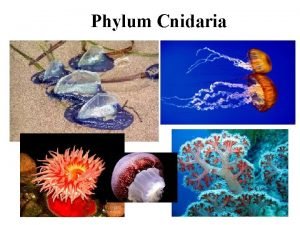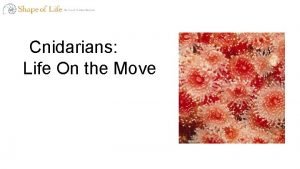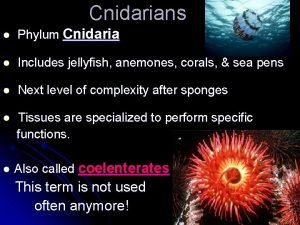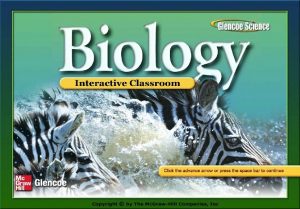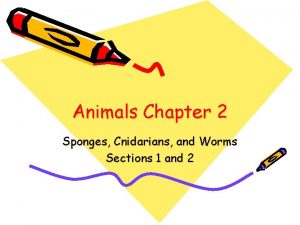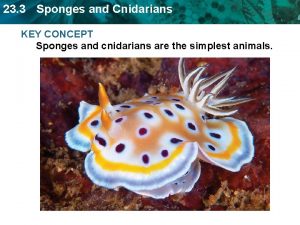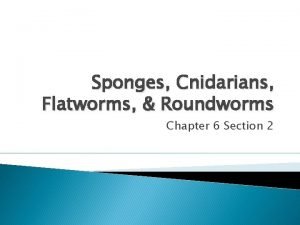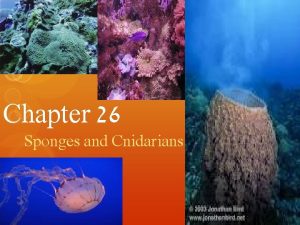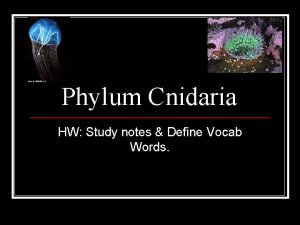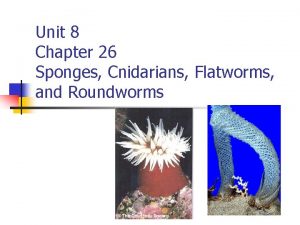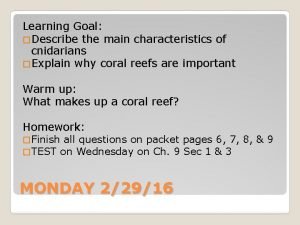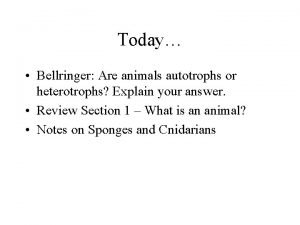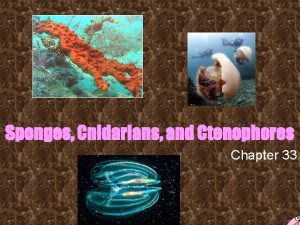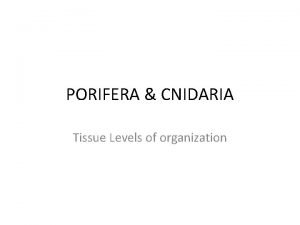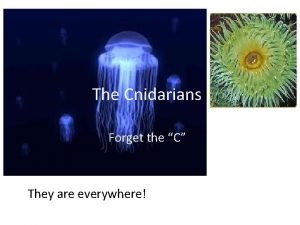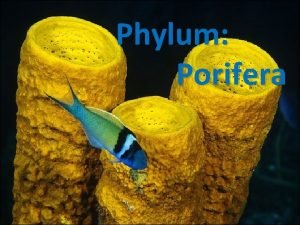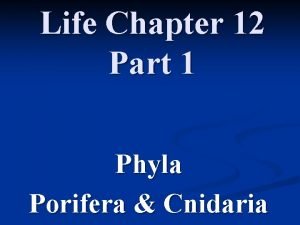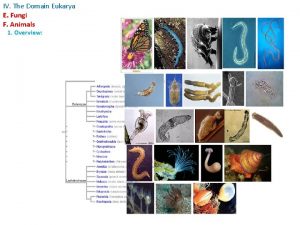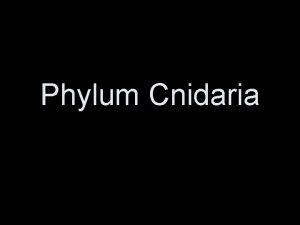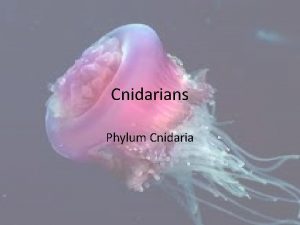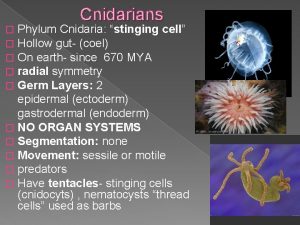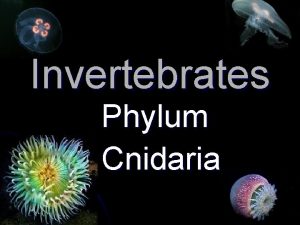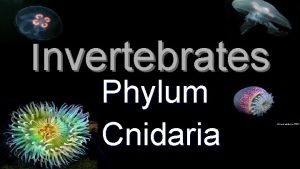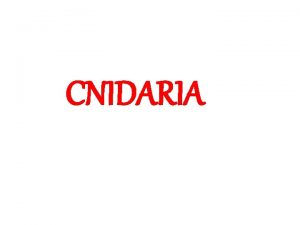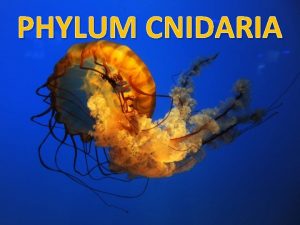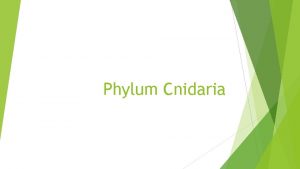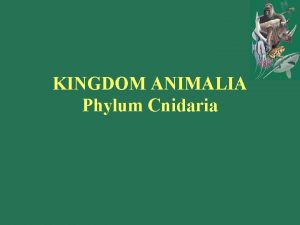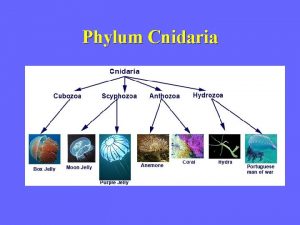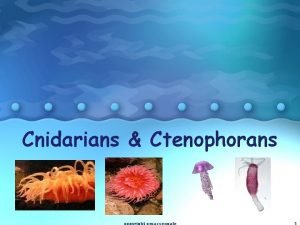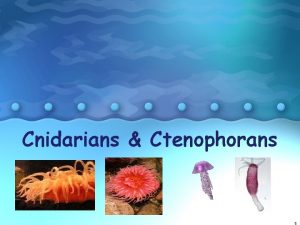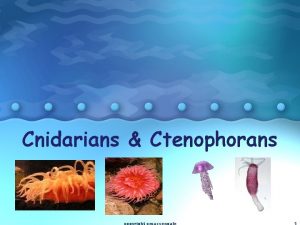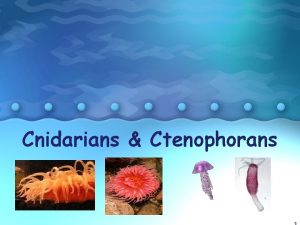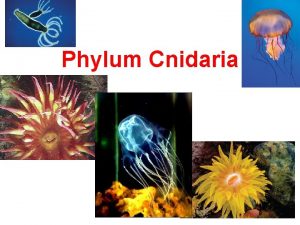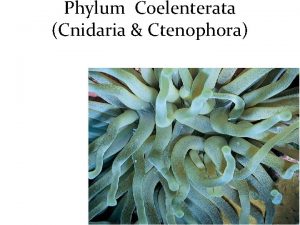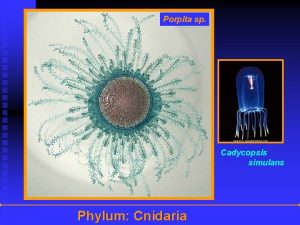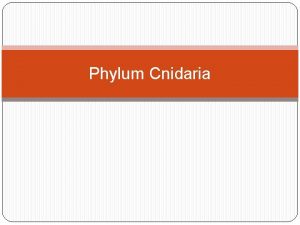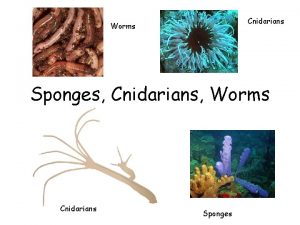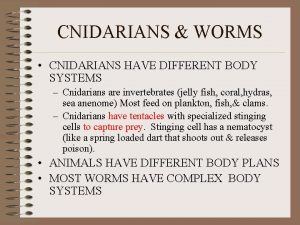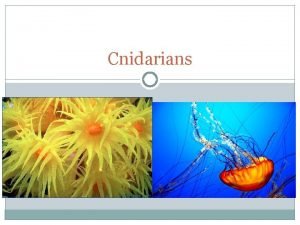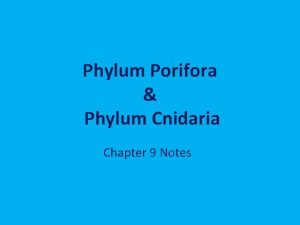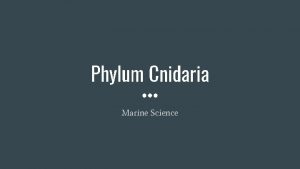Cnidarians Phylum Cnidaria stinging cell On earth since
































- Slides: 32

Cnidarians Phylum Cnidaria: “stinging cell” On earth- since 670 MYA radial symmetry Germ Layers: 2 epidermal (ectoderm) gastrodermal (endoderm) � NO ORGAN SYSTEMS � No Segmentation � Movement: sessile or motile � predators � Have tentacles- stinging cells (cnidocyts) , nematocysts “thread cells” used as barbs � �


Structures: � One body opening (mouth) for food to enter and wastes to exit � Gastrovascular cavity: interior cavity where food is digested & nutrients are circulated around the body � Nerve net: net of nerves that allow impulses to travel around the body, senses the environment Label the hydra on your notes! http: //www. arkive. org/common-jellyfish/aurelia-aurita/video-10. html

Without Body Systems, how do they survive? Nervous: Cephalization absent; Nerve Net� Skeleton: Hydrostatic- water pressure maintains shape � Respiration: Oxygen diffuses into body from water � Digestion: mouth, GVC � Excretion: simple diffusion into water � Circulation: GVC- gastrovascular cavity � Reproduction: asexual and sexual, alternation of generations �

Cnidarians: Body � Polyp: body with tentacles Forms facing upward, sessile � Ex: hydra, sea anemone � video polyp predation � Medusa: body with tentacles hanging downward, motile � Ex: jellyfish

Cnidarian Reproduction � Asexually: by budding � Sexually: usually in medusa form, sperm and eggs are released into water � (fertilized egg zygote planula larva adult) � Thousands of gametes are released at a time

Alternation of Generations: Video: medusa releasing from polyp

Checkpoint: 1. 2. 3. 4. 5. 6. List 5 traits that cnidarians share. How many germ layers do cnidarians have? ____ Which are they missing? Are all cnidarians predators? Motile? Describe the specialized cells they have on their tentacles. Describe how a cnidarian consumes and digests food. Describe the two body forms Cnidarians display, and give examples of each type.

Structure: The Polyp and Medusa Stages Epidermis Mesoglea Gastroderm Tentacles Mesoglea Gastrovascular cavity Mouth/anus Gastrovascular cavity Tentacles Medusa Polyp basal disc: sticky structure at the bottom of polyp ; sessile

Diploblastic - 2 germ layers › Epidermis - outer covering (ectoderm) › Mesoglea - middle non-living jelly-like layer (missing mesoderm) › gastrovascular cavity (endoderm) 11

Classes of Cnidarians 1. Hydrozoa 2. Scyphozoa 3. Anthozoa

Class Hydrozoa Freshwater & marine. � Medusa and polyp colonies which appear to be one organism� different types of polyps work together to serve the entire colony � Ex: Hydra, Obelia, Gonionemus Physalia (portuguese-man-of-war) 36: 00 Ocean Drifters � Asexual repro. -budding. � Sexual repro. via gametes � 13

Gonionemus Diagram � mouth � GVC � Gonad � mesoglea � tentacle

Class Scyphozoa � Scyph= “cup” � Large- Tentacles up to 70 meters in length � All marine � Independent medusa forms � Lack polyp stage or have for a very short time � Ex. Box jellyfish Big Jelly 15

Class Anthozoa � ANTHO=“flower” � All polyps-Medusa stage absent � Solitary or colonial � Some produce protective skeletons � All Marine � Ex. Sea anemones, corals 16

Class Anthozoa Sea Anemone Video jewel anenome 17

Class Anthozoa Metridium Tentacles Mouth Pharynx Septum Gastrovascular cavity 18

Symbiotic Relationship 19

Class Anthozoa Corals Polyp secretes protective skeleton of calcium carbonate � Polyp retracts when not feeding � 20

Corals Colony of interconnected polyps 21

Class Anthozoa Meandrina Brain Coral 22

Class Anthozoa Gorgonia Sea Fan 23

Class Anthozoa Tubipora Pipe Organ Coral 24

Class Anthozoa Actinodiscus Mushroom Coral 25

Class Anthozoa Acropora Staghorn Coral 26

Coral Reefs Formed over 1000’s of years from successive layers of coral skeletons � The underwater equivalent of the amazon jungle- very high species diversity and biomass � Reefs contain: � › sponges, colonial hydrozoans, anemones, many varieties of coral, fish, many types of worms we’ve not discussed…not to mention bryozoans, ctenophores, protists, bacteria, etc… 27

Copyright © The Mc. Graw-Hill Companies, Inc. Permission required for reproduction or display. Coral Reef Ecosystem Photo © Mc. Graw-Hill Higher Education, Barry Barker, Photographer 28



Cnidarian Cladogram Anthozoa Scyphozoa Hydrozoa Cubozoa Medusa cuboidal Loss of medusa Polyp stage reduced Septa divide gastrovascular cavity Radial symmetry, cnidocytes, planula larva 31

Checkpoint 1. Cnidarians are diploblastic, what does this mean? 2. What is the mesoglea? 3. How are Hydrozoans different from other classes of cnidarians? 4. List examples of Hydrozoans. 5. What are scyphozoans, do they have a polyp stage? 6. Anthozoans are known as the _______ animals. Give examples of anthozoans. 7. What is an anthozoan’s protective skeleton made of? 8. Why are coral reefs important?

The End 33
 Difference between hydrozoa and anthozoa
Difference between hydrozoa and anthozoa Cnidaria characteristic
Cnidaria characteristic Phylum cnidaria general characteristics
Phylum cnidaria general characteristics Zooids in cnidaria
Zooids in cnidaria General characteristics of cnidaria
General characteristics of cnidaria Chironex fleckeri classification
Chironex fleckeri classification Reproduction in obelia
Reproduction in obelia Hydra sea anemone
Hydra sea anemone Cnidaria characteristics
Cnidaria characteristics Metridium phylum
Metridium phylum Stinging trichomes
Stinging trichomes Alyconaria
Alyconaria Porifera images
Porifera images Jellyfish symmetry
Jellyfish symmetry Filum cnidaria
Filum cnidaria Cnidaria symmetry
Cnidaria symmetry L
L Chapter 24 section 1 animal characteristics answer key
Chapter 24 section 1 animal characteristics answer key Sponges cnidarians and worms
Sponges cnidarians and worms 2 body forms of cnidarians
2 body forms of cnidarians Chapter 26 sponges and cnidarians answer key
Chapter 26 sponges and cnidarians answer key Chapter 26 sponges and cnidarians
Chapter 26 sponges and cnidarians Define cnidocytes
Define cnidocytes Chapter 26 sponges and cnidarians answer key
Chapter 26 sponges and cnidarians answer key General characteristics of cnidarians
General characteristics of cnidarians Are cnidarians autotrophs
Are cnidarians autotrophs Section 33-1 review porifera answer key
Section 33-1 review porifera answer key Level of organization of cnidaria
Level of organization of cnidaria What do you see in this picture
What do you see in this picture Section 33-1 review porifera answer key
Section 33-1 review porifera answer key Porifera
Porifera Symmetry of porifera
Symmetry of porifera Coral phyla
Coral phyla
